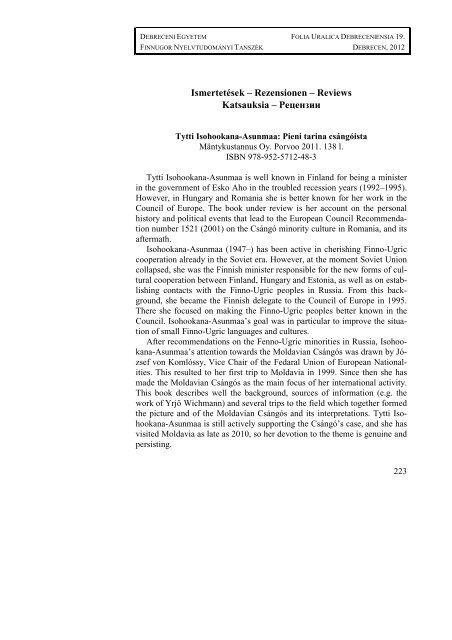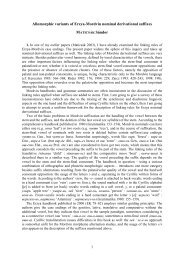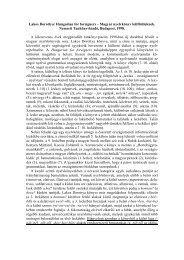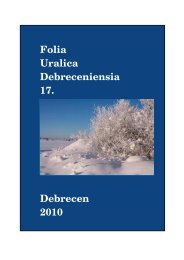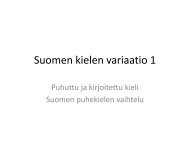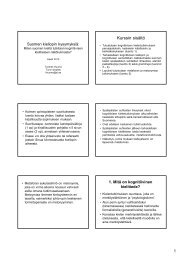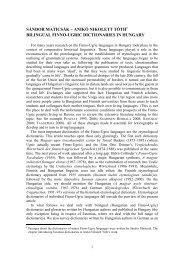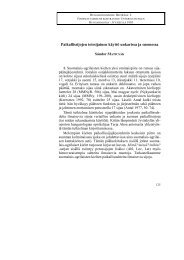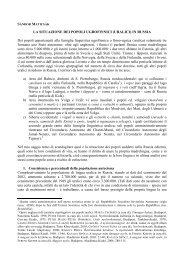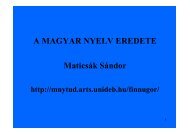folia uralica debreceniensia 19. - Finnugor Nyelvtudományi Tanszék
folia uralica debreceniensia 19. - Finnugor Nyelvtudományi Tanszék
folia uralica debreceniensia 19. - Finnugor Nyelvtudományi Tanszék
You also want an ePaper? Increase the reach of your titles
YUMPU automatically turns print PDFs into web optimized ePapers that Google loves.
DEBRECENI EGYETEM<br />
FINNUGOR NYELVTUDOMÁNYI TANSZÉK<br />
FOLIA URALICA DEBRECENIENSIA <strong>19.</strong><br />
DEBRECEN, 2012<br />
Ismertetések – Rezensionen – Reviews<br />
Katsauksia – Рецензии<br />
Tytti Isohookana-Asunmaa: Pieni tarina csángóista<br />
Mäntykustannus Oy. Porvoo 2011. 138 l.<br />
ISBN 978-952-5712-48-3<br />
Tytti Isohookana-Asunmaa is well known in Finland for being a minister<br />
in the government of Esko Aho in the troubled recession years (1992–1995).<br />
However, in Hungary and Romania she is better known for her work in the<br />
Council of Europe. The book under review is her account on the personal<br />
history and political events that lead to the European Council Recommendation<br />
number 1521 (2001) on the Csángó minority culture in Romania, and its<br />
aftermath.<br />
Isohookana-Asunmaa (1947–) has been active in cherishing Finno-Ugric<br />
cooperation already in the Soviet era. However, at the moment Soviet Union<br />
collapsed, she was the Finnish minister responsible for the new forms of cultural<br />
cooperation between Finland, Hungary and Estonia, as well as on establishing<br />
contacts with the Finno-Ugric peoples in Russia. From this background,<br />
she became the Finnish delegate to the Council of Europe in 1995.<br />
There she focused on making the Finno-Ugric peoples better known in the<br />
Council. Isohookana-Asunmaa’s goal was in particular to improve the situation<br />
of small Finno-Ugric languages and cultures.<br />
After recommendations on the Fenno-Ugric minorities in Russia, Isohookana-Asunmaa’s<br />
attention towards the Moldavian Csángós was drawn by József<br />
von Komlóssy, Vice Chair of the Fedaral Union of European Nationalities.<br />
This resulted to her first trip to Moldavia in 1999. Since then she has<br />
made the Moldavian Csángós as the main focus of her international activity.<br />
This book describes well the background, sources of information (e.g. the<br />
work of Yrjö Wichmann) and several trips to the field which together formed<br />
the picture and of the Moldavian Csángós and its interpretations. Tytti Isohookana-Asunmaa<br />
is still actively supporting the Csángó’s case, and she has<br />
visited Moldavia as late as 2010, so her devotion to the theme is genuine and<br />
persisting.<br />
223


